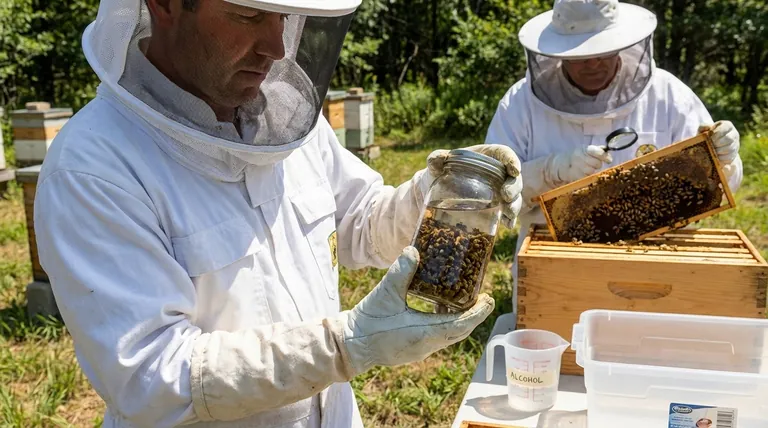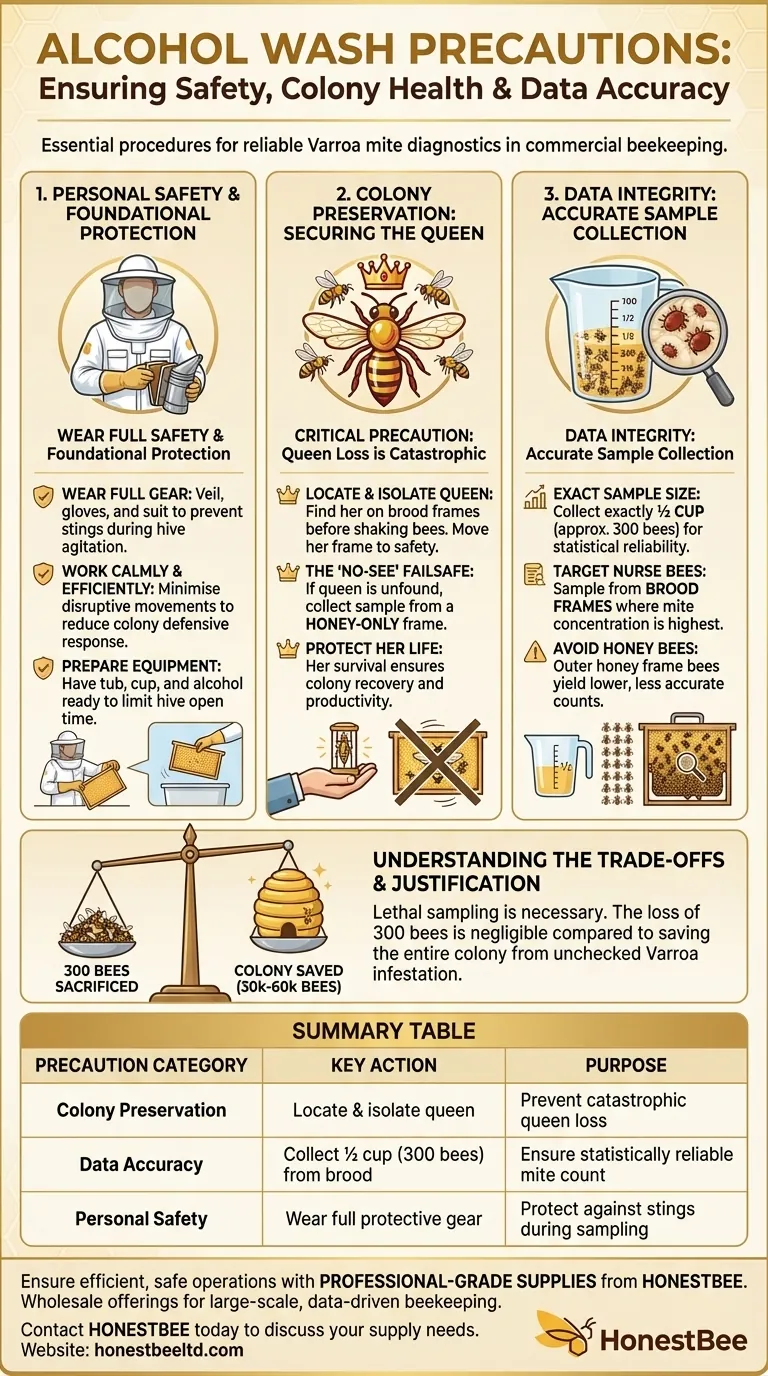The most important precautions for an alcohol wash fall into three categories: personal safety, colony preservation, and data accuracy. To perform the test correctly, you must wear protective gear to prevent stings, ensure the queen is not accidentally included in the sample, and collect the proper number of bees from the right location within the hive.
An alcohol wash is a powerful diagnostic tool, but its value is entirely dependent on correct procedure. The necessary precautions are not just about avoiding stings; they are essential for protecting the queen's life and ensuring the test results are reliable enough to guide your treatment decisions.

Foundational Safety: Protecting the Colony and Yourself
The first priority during any hive inspection, including an alcohol wash, is to manage the colony's defensive response and ensure your own safety.
Wear Appropriate Protective Gear
Collecting a bee sample is a disruptive act. You will be shaking or brushing bees off a frame, which will agitate the colony. Always wear your veil, gloves, and a bee suit or jacket to protect yourself from stings.
Work Calmly and Efficiently
Agitated bees release alarm pheromones, which signal a threat to the rest of the hive. Work deliberately but without jarring movements. Having your equipment (a tub for shaking, the measuring cup, and the jar of alcohol) ready beforehand will minimize the time the hive is open and distressed.
The Critical Precaution: Securing the Queen
Losing a queen is the single most damaging event that can happen to a colony. Taking precautions to protect her is not optional; it is the most critical part of the entire process.
Why the Queen's Safety is Paramount
The queen is the only bee that lays fertilized eggs, producing all the female worker bees. Her death can send the colony into a state of decline from which it may not recover. Accidentally killing her during a mite wash negates any benefit the test might provide.
How to Locate and Isolate the Queen
Before shaking any bees, you must find the queen. Systematically inspect frames that contain eggs and young larvae, as this is where she is most likely to be. Once you locate her, carefully place that frame outside the hive in a safe spot or have a fellow beekeeper hold it. Only then should you proceed with collecting your sample from other frames.
The 'No-See' Failsafe Method
If you cannot find the queen after a thorough check, do not risk it. The safest alternative is to choose a frame that contains only capped honey. The queen very rarely ventures onto honey-only frames, making them a much safer source for your sample. The mite count may be slightly less precise, but it avoids the catastrophic risk of killing the queen.
Ensuring Data Integrity: The Sample Itself
The entire purpose of the test is to get an accurate mite count. A poorly collected sample yields useless data and means the bees were sacrificed for nothing.
The Importance of a 300-Bee Sample
Scientific and field testing has established that a sample of approximately 300 bees provides a statistically reliable snapshot of the hive's overall mite infestation level. This corresponds to a level ½ cup of bees. A significantly smaller sample may not detect a low-level infestation, while a much larger one is unnecessarily destructive.
Where to Collect Your Sample for Best Results
Varroa mites reproduce on developing bee pupae. Therefore, the highest concentration of mites is typically found on the nurse bees that are caring for the brood. For the most accurate count, collect your sample from a frame containing brood (after you have secured the queen). Avoid bees on the outermost frames of honey, as they tend to have fewer mites.
Understanding the Trade-offs
An alcohol wash is a lethal test. It is crucial to understand why this sacrifice is considered a necessary and valuable management practice.
The Inevitable Loss of Bees
The 300 bees in your sample will be killed by the alcohol. For new beekeepers, this can be a difficult action to take.
The Justification for Lethal Sampling
A healthy summer colony contains 30,000 to 60,000 bees. The loss of 300 individuals is a negligible price to pay for the critical information gained. An unchecked Varroa mite infestation will kill the entire colony. The accurate data from an alcohol wash empowers you to treat the hive effectively, saving tens of thousands of bees for the cost of a few hundred.
Making the Right Choice for Your Goal
By focusing on the reason for each precaution, you can execute the test with confidence.
- If your primary focus is colony health: Absolutely confirm the queen's location and isolate her before proceeding. If you can't find her, take the sample from a honey frame as a failsafe.
- If your primary focus is data accuracy: Use a ½ cup measure to get exactly 300 bees, and collect them from a frame containing brood, where mite concentrations are highest.
- If your primary focus is personal safety: Wear your full protective gear. Collecting bees is an aggressive action that will provoke a defensive response from the colony.
Following these precautions transforms the alcohol wash from a simple task into a precise diagnostic procedure that protects you and your colony's future.
Summary Table:
| Precaution Category | Key Action | Purpose |
|---|---|---|
| Colony Preservation | Locate & isolate the queen before sampling | Prevent accidental queen loss, which is catastrophic for the hive |
| Data Accuracy | Collect exactly ½ cup (300 bees) from a brood frame | Ensure a statistically reliable mite count for effective treatment decisions |
| Personal Safety | Wear full protective gear (veil, suit, gloves) | Protect against defensive bee stings during the disruptive sampling process |
Ensure your beekeeping operations are efficient and safe with professional-grade supplies from HONESTBEE.
Whether you manage a commercial apiary or distribute beekeeping equipment, our wholesale-focused offerings—including durable protective gear, precise measuring tools, and reliable hive management equipment—are designed to support large-scale, data-driven beekeeping.
Contact HONESTBEE today to discuss your supply needs and enhance your diagnostic and safety protocols.
Visual Guide

Related Products
- Wholesales Dadant Size Wooden Bee Hives for Beekeeping
- Langstroth Screen Bottom Board for Beekeeping Wholesale
- Professional Galvanized Hive Strap with Secure Locking Buckle for Beekeeping
- Long Langstroth Style Horizontal Top Bar Hive for Wholesale
- Professional Plastic Queen Excluder for Modern Beekeeping
People Also Ask
- Why were wooden hives traditionally preferred? For Natural Beekeeping Aligned with Bee Biology
- What should beginners consider when purchasing beekeeping equipment? A Guide to Essential Starter Gear
- What is the best place to keep bees? Find the Perfect Apiary Site for Your Hives
- What types of products are available for beekeeping needs? Essential Equipment for Apiaries & Distributors
- What are the essential pieces of equipment for most beekeepers? Get Started with the Right Gear



















